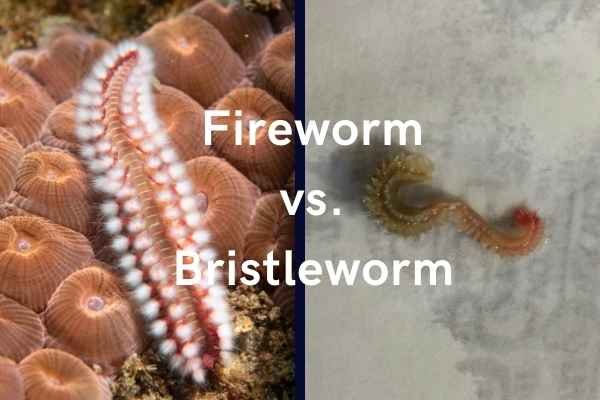
Imagine you’re strolling along a beach or exploring tide pools, and you spot a colorful, wiggly worm. Your curiosity piques, but so does your caution. After all, you don’t want to end up with a painful bite! In this article, we’ll unravel the differences between **fireworms** and harmless **bristle worms**, making sure you can identify them like a pro. Let’s dive in!
What Are Fireworms?
Fireworms belong to the *Hermodice sanguinea* species and are commonly found in warm coastal waters. These creatures have a vibrant appearance, often showcasing colors ranging from bright red to purple. Their defining features include long, thin bodies covered with hair-like bristles called chaetae. You might think of fireworms as the dramatic artists of the marine world—they’re flashy, easy to spot, and certainly memorable.
However, there’s a twist to their beauty. Fireworms are known for their painful bites. When threatened, they can quickly release a venom that causes irritation and a burning sensation, hence their name. It’s like touching a hot stove—you’ll definitely remember the experience, but you’ll also learn to be more cautious next time!
Habitat and Behavior of Fireworms
Fireworms thrive in tropical and subtropical waters, often hiding among rocks, coral reefs, and seagrass beds. They play a crucial role in the marine ecosystem by breaking down organic material. Despite their unpleasant bite, they help keep the environment healthy by recycling nutrients.
In terms of behavior, fireworms are mostly nocturnal. That means they come out at night to forage for food, which consists mainly of detritus, algae, and decaying matter. Think of them as the night owls of the ocean, working quietly while most of us are asleep.
What Are Harmless Bristle Worms?
Now, let’s talk about the friendly cousin: bristle worms. These creatures also belong to the class *Polychaeta* and boast a wide range of colors and sizes, depending on the species. Most bristle worms have a segmented body covered with chaetae, just like fireworms. However, don’t let their physical similarities fool you! Unlike fireworms, most bristle worms aren’t harmful to humans.
Bristle worms are often your allies in the marine world. They help aerate the substrate of seas and oceans, promoting a healthy ecosystem. They’re like the unsung heroes of underwater gardens, working behind the scenes with no need for fanfare.
Habitat and Behavior of Harmless Bristle Worms
You can find bristle worms in various environments, from sandy ocean floors to tidal pools. They tend to be less picky than fireworms about where they live. This adaptability allows them to thrive in many locations. They come out during the day to scavenge for food like detritus, algae, and tiny plankton.
In contrast to fireworms, bristle worms exhibit a more laid-back behavior. They are generally less aggressive and typically retreat to their hiding spots when threatened. Think of them as the peaceful gardeners of the ocean floor, quietly going about their business while avoiding conflict.
How to Identify Fireworms and Bristle Worms
You might be wondering how to tell these two apart without getting too close. Here are some key characteristics to help you identify fireworms versus harmless bristle worms:
- Color: Fireworms often display bright shades, mainly reds and purples, while bristle worms can be brown, green, or even gray.
- Size: Fireworms can grow longer, often reaching up to 12 inches, whereas many bristle worms are much shorter, around 3 to 8 inches.
- Bristles: Both have bristles, but fireworms’ bristles are typically more pronounced and can be irritating.
- Movement: Fireworms tend to move faster and more erratically, while bristle worms move in a more serpentine and smoother style.
Being able to distinguish between these two types of worms can save you from unnecessary pain and discomfort. Next time you’re by the water, remember these tips!
Why It Matters: Environmental Impact
Understanding the difference between fireworms and bristle worms is essential, not just for your safety but also for the health of marine ecosystems. Fireworms, while beautiful, can be harmful to reef health when present in large numbers. Their feeding habits can damage delicate corals, disrupting the balance of the ecosystem.
On the flip side, bristle worms contribute positively by breaking down organic matter and recycling nutrients. Recognizing each creature’s role helps us appreciate the complex relationships in marine habitats. Plus, it’s good to know who your underwater neighbors are!
Common Questions About Fireworms and Bristle Worms
You might have some lingering questions about these creatures. Here are a few common curiosities:
– **Can I get bitten by both?** Not normally. Bristle worms rarely bite, while fireworms have a painful sting.
– **Are they both safe for aquariums?** Generally, bristle worms can be beneficial in aquariums, while fireworms might need to be monitored closely.
– **How do I handle them?** If you encounter a worm, it’s best to observe from a distance—especially with fireworms.
Let me explain, knowing the difference between these two worms can enrich your adventures and ensure you have a safe experience by the water.
In summary, identifying fireworms versus harmless bristle worms is much more than a simple classification—it’s about respecting and understanding the biodiversity of our oceans. By knowing the differences, you can appreciate marine life without the fear of an unexpected bite.
So, whether you’re a beachgoer, a budding marine biologist, or just someone who enjoys a day at the coast, you can now take your newfound knowledge with you. Keep an eye out for those vibrant fireworms and the subtle charm of harmless bristle worms. Your beach adventures will never be the same!
